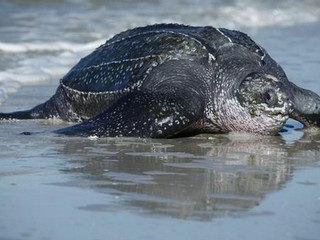Some of the most interesting and useful leatherback sea turtle facts including its habitat, diet, reproduction and species have been discussed in this article. The leatherback sea turtle (Dermochelys coriacea) is the largest among all the living sea turtles. These types of reptiles are also known as Lute Turtles. Leatherback sea turtles have evolved more than 110 million years ago. These animals are closely associated with the Cheloniidae family. These reptiles had been listed as an endangered species in United States under the Endangered Species Act back in 1970. Leatherback sea turtles have been disappeared from most of the oceans worldwide.
Leatherback Sea Turtle Facts
Leatherback sea turtles have large pair of flappers that allow them to swim rapidly. There are no claws on these flappers. As compared to their body size, these flappers are considered to be the largest with the length measuring at 2.7 meters (8.9 feet).
The weight of these turtles is 250 – 700 kg (550 – 1,500 lb).
These species have 1 – 1.75 m (3.3 – 5.64 feet) long carapace. Leatherback sea turtles measure 1.83–2.2 metres (6.0–7.2 ft) by length. The largest leatherback ever recorded was at 2.6 meters (8.5 feet), with the weight measuring 916 kg (2,020 lbs) in the west coast of Wales in 1988.
The body temperature of adult turtles above the water is about 18 °C (32.4 °F). These reptiles are by far one of the deepest living aquatic animals in that they go 1,280 meters (4,200 feet) in-depth.
You may also like to read: Why is Leatherback Sea Turtle Endangered?
The duration of dive is about 3 – 8 minutes, with the maximum duration is counted to 30 – 70 minutes.
Leatherback sea turtles are by far the fast swimmers with a speed of 35.28 kilometers per hour (21.92 mph). Nevertheless, the average speed is 0.5–2.8 metres per second (1.1–6.3 mph). This much speed places them in the Guinness Book of World Record as the fastest swimmers.

Where Do Leatherback Sea Turtles Live?
These reptiles are extensively distributed across Alaska, Norway, Africa, New Zealand, Cape of Good Hope and Atlantic. Leatherback sea turtle facts about its habitat and geographic distribution display that these reptiles are known to reside in the tropical and subtropical waters extending to the Arctic Circle. The largest concentration of these turtles is found in the Rantau Abang beach, Malaysia hosting more than 10,000 individuals.
The global nesting has been significantly reduced over the years with 115,000 estimated in 1980. However, the numbers have fallen down to 26,000 – 43,000 female nests. These animals are inhabitants of Gulf of Saint Lawrence, French Guiana, Mayumba, Gabon (more than 30,000 individuals exist today) and other places of the Atlantic coast of Canada. Some of these species also dwells in Florida. Leatherback sea turtles are found in the Northern Hemisphere, Solomon Islands, California, Papua beaches, Southern Hemisphere, Mexico, and Costa Rica, and Columbia River. These turtles are mainly found in the wide open waters and they travel 20,000 km (12,000 miles) within a period of almost 2 years. This traveling usually takes place between Indonesia and United States. They do not dive deeply during night.

What Do Leatherback Sea Turtles Eat?
These sea turtles predominantly eat Californian Jellyfish and they migrate 6,000 miles (9,700 km) all throughout the Pacific. Plastic bags are making these species extinct since these bags resembles too much with the jellyfish. One-third of the plastic bags are known to be ingested by these reptiles.
The lifespan of leatherback sea turtles is 30 – 50 years.
These turtles are predated by tiger sharks and killer whales. More than 90% are killed by these intruders.
Leatherback Sea Turtle Facts | Reproduction
- The clutch size comprises 110 eggs. Females lay 8 – 9 eggs in a breeding season.
- The incubation (keeping warm) period lasts for about 20 – 25 days.
- The nesting period ranges from March to August. Some species have nesting in the months of February and ends on July.
Species
- Dermochelys coriacea
- Sphargis coriacea schlegelii.
- D. coriacea coriacea
- D. coriacea schlegelii
Leatherback Sea Turtle Facts | Videos







Leave a Reply